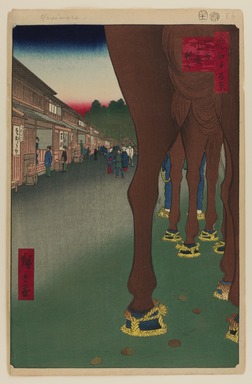
Artist:Utagawa Hiroshige
Medium: Woodblock print
Geograhical Locations:
Dates:11th month of 1857
Dimensions: Sheet: 14 3/16 x 9 1/4 in. (36 x 23.5 cm) Image: 13 3/8 x 8 3/4 in. (34 x 22.2 cm)
Collections:
Exhibitions:
Accession Number: 30.1478.86
Image: 30.1478.86_PS20.jpg,
Catalogue Description:
Both European and Japanese observers have objected to this print due to the lowness of its subject matter. It can also be argued that it is in fact an "appropriate expression of the place." (H. Smith, in Braziller, N.Y. 1986) Naito Shinjuku was founded in 1698 by a group of Yoshiwara brothel owners and was intended from the start as a semiofficial center of prostitution, like Shinagawa Senju and Itabashi, the other stops along the major highways out of town. Shinjuku was named after the daimyo whose estate was reduced in size to make room for it. It was closed in 1718 after a samurai brawl and reopened in 1782, after which time it became most profitable. The artist has offered a detailed view, not only of the butt of the horse and its scattered droppings but also of the straw sandaled hooves of the horses. The trees beyond surround the guard station at the terminus of the Tamagawa Canal, next to Yotsuya Gate, the entrance to Edo from the west. Today, Shinjuku Station is one of the world's largest rail terminals, serving more than a million passengers daily. The huge skyscraper development just west of the station is the location of Tokyo's new City Hall.